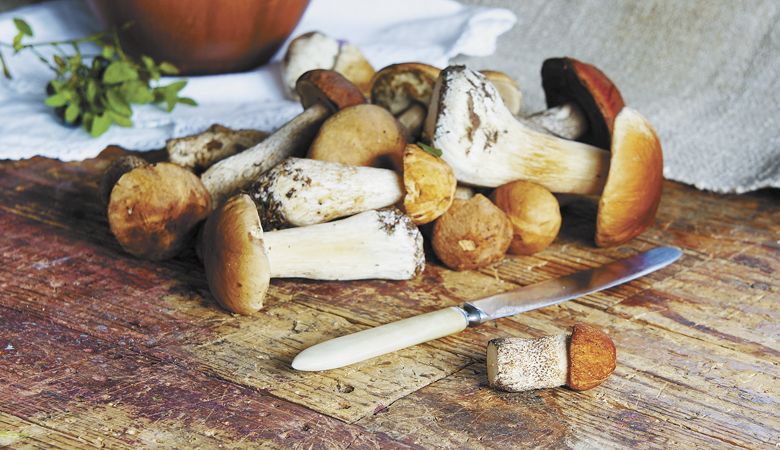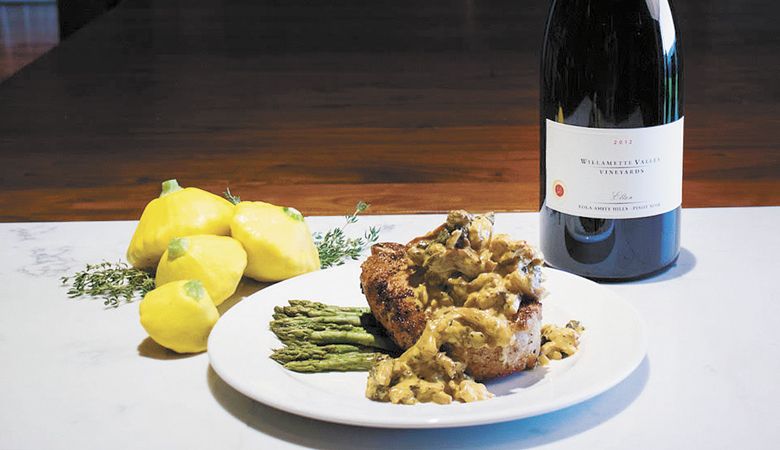Dishing the Dirt
Forage and feast on fall’s fungal bounty
By Annelise Kelly
October. Golden leaves fall softly in crisp cool air, days shorten, rains return. The autumn harvest replaces summer’s waning bounty.
In Oregon, autumn means wild mushrooms. They thrive in the woodsy Pacific Northwest, nestled in the soft loam of our conifer and hardwood forests, sending intricate mycelium networks through the soil from which mushrooms, the fruiting body of the fungus, sprout.
Golden and white chanterelles, king boletes, matsutakes, hedgehogs, cauliflowers, lobster. These rich, meaty morsels pop up in the woods, at the farmers’ market and even at local grocery stores. Menus herald the season: The Joel Palmer House in Dayton celebrates the fall festival of fungi with a Mushroom Madness tasting menu, with five courses featuring an impressive catalog of mushrooms.
We asked for advice from three local experts. Whether you plan to prowl the woods or the local markets, learn from their many years pursuing Oregon’s fungal bounty. DJ MacIntyre, executive winery chef at Willamette Valley Vineyards, Jennifer Macone, co-founder and co-owner of The Mushroomery; and Stefan Czarnecki, owner and president of wine tour company Black Tie Tours, all shared their expertise on the subject.
Czarnecki recalls foraging with his grandfather in the woods around Reading, Pennsylvania, where his family had run a restaurant since 1916. “When we were back East, we had to learn many, many varieties because there weren’t huge crops of the prime mushrooms.” The family moved to the Willamette Valley when his father, Jack Czarnecki, launched the Joel Palmer House restaurant in Dayton. “Our first fall was 1997. It was kind of wet, not great for wine but amazing for mushrooms. We got about 150 pounds of porcinis off Mount Saint Helens in a couple days -- that was our introduction to the Pacific Northwest.”
For Jennifer Macone, mushroom hunting gratifies because “as far as community, I really like to bring food to people that they don’t normally have access to, something special. The woods are full of mushrooms. If you know your edible mushrooms, during peak season after the rains come, you can always find at least enough for dinner.”
Chef MacIntyre from Willamette Valley Vineyards loves “being out in the wilderness, out in nature, with friends, roaming the underbrush, climbing hills. And the abundance – the whole state has an abundance of foraged food; it’s free and delicious.”
Safety remains a critical concern when foraging for wild mushrooms. Poisonous look-alikes trick novice hunters with dire consequences. The best way to learn is accompanying an experienced forager. Czarnecki suggests outings with local mycological organizations. “You can meet new people at the same level of foraging, they’re led by experts, and you can learn so much in just one day.” He says there’s no substitute for holding them in your hands, cutting them, and feeling them to hone your skills. He recommends books such as “Mushrooms Demystified” by David Arora and “The Audubon Society Field Guide to North American Mushrooms” by Gary Lincoff. MacIntyre favors foldable laminated guides for use in the field.
For wilderness safety, bring food, water, a charged phone, a whistle and dress for the weather. Tell people where you are going and when you expect to return. Bring a compass: Mushroom hunting means lots of walking in circles with your head down, so it’s easy to lose your sense of direction. Check local regulations for permit requirements, and forage on private property only with owner consent.
A basket, a sharp knife and a brush are the tools of the mushroom forager. Baskets are better than bags because they prevent the delicate fungi from jostling and breaking, and they allow the spores to drift out and propagate, according to some experts. Brushing off dirt and pine needles means less washing later.
Whether your bounty of wild local mushrooms comes via the woods or the market, they are culinary superstars.
Macone appreciates that “each one is distinct in flavor and texture. They can blend into any meal. The cauliflower mushroom has an egg noodle texture; chicken of the woods has a texture like chicken or tofu and a chickeny flavor.” Plus, they are high in protein and one of the few non-fortified culinary sources of vitamin D. “They’re finding out that mushrooms have all kinds of medicinal properties,” added Macone. MacIntyre marvels that “they go with everything in the Pacific Northwest,” including steelhead, nettles, spruce tips, and fruit and berry flavors.
Cooking wild mushrooms doesn’t have to be complicated. Simple preparation really highlights their earthy flavors.
“Most bad experiences I hear about is if the mushrooms are too chunky after they’re cooked, so I always suggest slicing them thinly,” said Macone. “Especially if you haven’t tried that variety before, slice it very thin, sauté with a little garlic or onion and the oil of your choice, and serve it on top of something so you can learn its flavor profile. Some shrink a lot; some don’t shrink at all. This helps getting to know your mushroom and how it cooks up.” Her favorite treatment? Adding them to soups, stews and slow-cooker dishes. “I think the flavor seeps out and makes the dish really amazing. I put them in a split pea soup recently; it was fantastic.”
MacIntyre emphasizes that they’re hearty enough to go with pork or beef, but also great by themselves. He recommends roasting them on a cedar or alder plank. Toss them with lemon zest and juice, a little thyme, oregano and sage, olive oil, and salt and pepper, then roast on the plank for about 12 minutes at 425 degrees. “They get nice and creamy inside, a whole lot of flavor,” he said.
Czarnecki family tradition considers soy sauce, sugar and salt essential seasoning for mushrooms. A touch of soy sauce brings out the umami, sugar tempers the soy sauce and salt boosts the flavor. He confesses he’s picky about mushrooms, sometimes finding the texture a barrier, but “my family has always had a knack for cooking them in a way that tastes good to me. The Joel Palmer House soup, the Three Mushroom Tart — my mother’s recipe — just lights-out so good.”
The Czarnecki family was drawn to the Willamette Valley in part by its flourishing wine culture. “The natural earthiness of Oregon Pinot Noir is a good pairing with mushrooms. They go so well with rich foods, with cream and butter, and those match well with Pinot Noir.” Chardonnay, Pinot Gris and Cabernet Sauvignon also make great pairings with wild Oregon fungi.
Recipes by Chef DJ MacIntyre, Willamette Valley Vineyards
Beef Stroganoff with Wild Mushrooms
Makes 4 servings
INGREDIENTS
1 pound beef sirloin, thinly sliced
2 cups creminis, sliced ¹/8 inch
1½ cups creminis, grated
1 cup wild mushrooms, sliced ¹/8 inch
2 tablespoons minced garlic
1 tablespoon + 1 teaspoon kosher salt
1 bay leaf
1 tablespoon dried thyme
2 teaspoons black pepper
¼ cup extra virgin olive oil
1 cup red wine
2 tablespoons tomato paste
2 tablespoons mushroom base (Better Than Bouillon)
1 quart heavy whipping cream
1 cup sour cream
* fresh tarragon leaves
DIRECTIONS
1. In heavy-duty skillet, heat oil on medium-high and sear beef on one side. Stir and then add garlic, mushrooms and spices. Stir well, cooking until mushrooms start to break down.2. Deglaze with red wine; then add tomato paste and mushroom base.3. Once well mixed, add heavy cream and adjust heat to low simmer. Reduce volume by 25%; then add sour cream to thicken. 4. Serve over fresh hot pasta; garnish with tarragon leaves.
Roasted Pork Chop with Wild Mushroom Ragout
Makes 4 servings
FENNEL SEASONING
½ cup kosher salt
¼ cup freshly ground pepper
2 tablespoons fennel seeds
2 tablespoons celery seeds
PORK CHOPS
4 pork chops
3 tablespoons fennel seasoning (see above)
1½ cup creminis, quartered
¾ cup wild mushrooms, sliced ½ inch
¼ cup butter, unsalted
1 tablespoon garlic, minced
1 teaspoon lemon zest
1 tablespoon thyme leaves, fresh
½ cup white wine
1 cup whipping cream
½ cup chicken stock
DIRECTIONS
1. Fennel Seasoning: Toast both celery and fennel seeds in sauté pan over medium-high heat for 3 minutes, stirring constantly to ensure even toasting and to prevent burning. Transfer to spice grinder and grind to powder. Add salt and pepper; mix well and hold at room temperature. 2. Pork Chops: In sauté pan, melt butter and sauté garlic and onions over medium heat. When onions begin to sweat, add mushrooms, thyme leaves and lemon zest. Continue to sauté until mushrooms break down and start to brown. 3. Deglaze with wine and then add chicken stock. Reduce chicken stock by 50%; then add whipping cream and 1 tablespoon of fennel seasoning. Continue to reduce over medium heat until cream is 25% gone and sauce starts to thicken. 4. While sauce is reducing, season pork chops with remaining fennel seasoning and roast to desired temperature (internal temperature of 140°F is medium done.) Let pork chops rest for 5 minutes and then pour the mushroom sauce over top. 5. Serve with favorite starch and vegetables.












